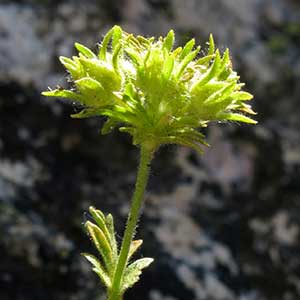Ivesia arizonica
Ivesia longibracteata
purpusia, rock whitefeather
Castle Crags ivesia, longbract mousetail
pendent or prostrate to ascending, (0.2–)0.5–1.6(–3) dm.
ascending to erect, 0.3–1.2 dm.
planar, 2–15(–20) cm; sheathing base usually not strigose abaxially;
petiole 3–10 cm;
lateral leaflets (2–)3–4(–5) per side, separate, broadly ovate or obovate to orbiculate, (2–)5–15(–18) mm, incised 1/4–3/4 to base into (3–)7–11 ± ovate teeth, apex not setose, surfaces ± sparsely short-pilose, ± glandular;
terminal leaflets ± distinct.
weakly planar to loosely ± cylindric, (0.5–)2–4(–6) cm; sheathing base glandular abaxially, otherwise glabrous;
petiole 0.5–2 cm, hairs 0.2–1 mm;
leaflets 5–6 per side, 2–6 mm, ± short-hirsute, glandular-puberulent, lobes 2–7, oblanceolate to spatulate or obovate, apex not setose.
1–3;
blade well developed.
1–3, not paired.
(1–)5–30(–150)-flowered, open, 0.5–14 cm diam.
3–14-flowered, 1–2.5 cm diam.;
glomerules 1.
5–30 mm.
1.5–6 mm.
6–12 mm diam.;
epicalyx bractlets 0(–3), lanceolate, 0.9–1.8 mm;
hypanthium turbinate or campanulate, 1.5–3(–5) × 1–3(–4) mm;
sepals 2–4(–5) mm, acute;
petals yellow or white, oblanceolate to elliptic or obovate, (1.6–)2–4 mm;
stamens 5, filaments 0.8–1.3 mm, anthers ± yellow, oblong to narrowly ovate, 0.6–1.5 mm;
carpels (2–)6–10(–13), atop a stipelike torus, styles 0.9–1.8 mm.
8–10 mm diam.;
epicalyx bractlets linear to narrowly lanceolate or elliptic, 2.5–5 mm, longer than sepals;
hypanthium shallowly cupulate, 0.5–1 × 2–3 mm;
sepals 1.5–2.5 mm, ± acute;
petals pale yellow, linear to narrowly oblanceolate, 1.5–2.5 mm;
stamens 5, filaments 0.7–1.3 mm, anthers yellow, 0.5–0.8 mm;
carpels 6–11, styles 1–1.5 mm.
greenish white to light tan, 1.2–2 mm, faintly rugose, ± carunculate.
cream to light tan, 1.2–1.5 mm.
Ivesia arizonica
Ivesia longibracteata
Varieties 2 (2 in the flora).
Because the epithet saxosa was retained for Potentilla saxosa upon transfer to Ivesia, a different epithet (arizonica) was needed when Purpusia was likewise transferred in the same publication (B. Ertter 1989). The correct name for this species in Potentilla is P. osterhoutii (A. Nelson) J. T. Howell, due to the existence of P. arizonica.
(Discussion copyrighted by Flora of North America; reprinted with permission.)
Of conservation concern.
Ivesia longibracteata is known only from the Castle Crags area of Shasta County. The epithet alludes to a diagnostic characteristic unique in the genus: the epicalyx bractlets are longer than the sepals. The plants grow on vertical rock faces, a habitat more characteristic of sect. Setosae; however, the stems are ascending to erect and do not form hanging clumps, and the pedicels are not curved in fruit.
(Discussion copyrighted by Flora of North America; reprinted with permission.)
1. Petals yellow; hypanthia campanulate. | var. arizonica |
1. Petals white; hypanthia turbinate. | var. saxosa |
